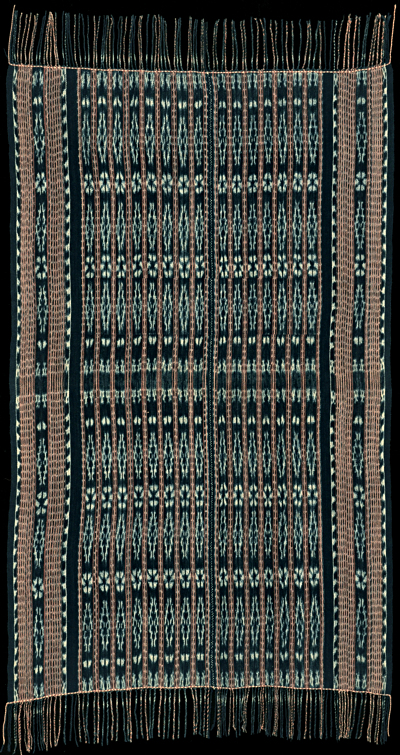| |
 
 | | | |
117 Savu Group, Raijua
Selendang (shawl)  
| | Locale: | Village unknown. | | Period: | 1930-1950. | | Yarn: | Cotton, hand-spun, coarse | | Technique: | Warp ikat | | Panels: | 2 | | Size: | 86 x 136 cm (2' 9" x 4' 5") LW: 1.58 | | Weight: | 505 g (17.8 oz), 432 g/m2 (1.42 oz/ft2) | | Design: | Hi'i wo hepi of the category henguru pidu, meaning that it has seventeen bands of main ikated motif, the second highest class - the classification system running from five to nineteen. Light indigo field covered with wo hepi pattern (elongated and crenelated lozenges) in blueish white and numerous narrow mauve stripes. Note the asymmetry, which is prescribed for this type of cloth: not counting the borders, the left part of the midfield has eight columns of wo hapi, the right part only seven. | | Comment: | Rare. Well preserved example of Raijua hi'i wohepi. Soft tones, soft feel. Pewarna alami - all natural dyes and hand spun yarn. | | Background: | Chapters on Savu Group and Raijua. | | Compare: | 142 143 111 | | Sources: | Very similarl to hi'i with fifteen bands (wo henguru lemi) in Duggan, Woven Stories, p. 85 bottom. Similar to wrap depicted in Khan-Majlis, Woven Messages, Fig. 231, but with different colouration, with blue here instead of rust-red. See also Fraser-Lu, Handwoven Textiles, p.200. | | |

©Peter ten Hoopen, 2025
All rights reserved.
|
|


